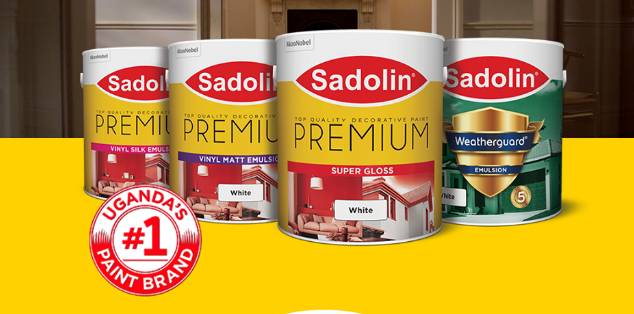Sadolin Paints which re-launched on the Ugandan market and announced Crown Group, manufacturers of Regal Paints as their new local partners has reaffirmed their commitment to promoting efforts to prevent childhood lead poisoning and specifically laws to eliminate lead in paint.
AkzoNobel’s (Sadolin brand owner) on Friday told journalists they do not sell lead paint for use in homes, schools and other buildings.
This follows claims that Lead paints are still on Ugandan market made by Mr. Frank Muramuzi the executive director of the National Association of Professional Environmentalists (NAPE).
“At Sadolin are cautious about the human health effects of lead exposure,” said Sadolin head of public relations Felix Adupa Ongwech. “We are going to produce Lead-free paints following international standards.” Sadolin brand is once again going to be locally manufactured and available in the market place supported through AkzoNobel technology and innovation which it has got globally in more than 80 countries in which they operate in.
He added: “We are ready to collaborate with NEMA and other stakeholders who are drafting and consequently developing legislation and the necessary regulations that will control use of paints that contain total lead concentrations exceeding 90 ppm, the most restrictive standard in the world.”
NAPE war on Lead paints
Lead also causes long-term harm in adults, including increased risk of high blood pressure and kidney damage. Exposure of pregnant women to high levels of lead can cause miscarriage, stillbirth, premature birth and low birth weight, as well as minor malformations.
Lead exposure is estimated to account for 143 000 deaths per year with the highest burden in developing regions.
And Mr. Muramuzi said that NAPE with support from IPEN carried out a study to assess the levels of lead in paint that is produced in Uganda. Twenty out of 30 analysed solvent-based paints for home use (67% of paints) were lead paints, that is, they contained lead concentrations above 90 parts per million (ppm, dry weight of paint). This is also the regulatory limit for lead in decorative paint in, for example, India, the Philippines and the United States of America.
Moreover, 11 paints (37% of paints) contained dangerously high lead concentrations above 10,000 ppm. The highest lead concentration detected was 150,000 ppm in two yellow paints sold for home use.
On the other hand, 10 out of 30 solvent-based paints for home use (33% of paints) contained lead concentrations below 90 ppm, suggesting that the technology to produce paint without lead ingredients exists in Uganda.
Twelve out of 14 analysed brands (86% of paint brands) sold at least one lead paint, that is, a paint with lead concentration above 90 ppm. Nine out of 14 analysed brands (64% of paint brands) sold at least one lead paint with dangerously high lead concentrations above 10,000 ppm.
Drinking water delivered through lead pipes or pipes joined with lead solder may contain lead. Much of the lead in global commerce is now obtained from recycling.
NAPE has been calling upon government to tighten controls on the disposal of lead and lead contaminated waste. Encouragingly, the successful phasing out of leaded gasoline has resulted in a significant decline in population-level blood lead concentrations. It is also a good indication that with commitment lead poisoning can be eliminated in Uganda.
For feedback and story tips, contact: stephenmuneza@gmail.com, +256772544870 (Whatsapp) 0705367895 or Twitter @stephenkmuneza










